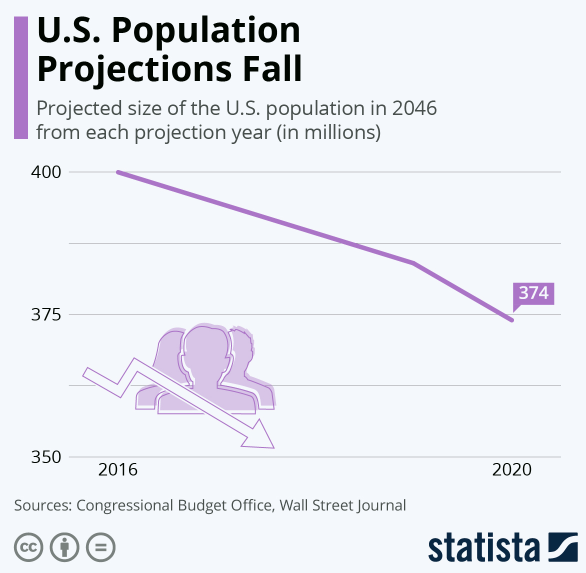COVID-19 could see U.S. population shrink faster

The pandemic is set to cause a substantial decline in birth rates. Image: Unsplash/Larry Crayton
- COVID-19 is set to result in a further fall in the U.S. population growth.
- According to the latest estimates by the U.S. Congressional Budget Office, U.S. population will be 374 million by 2046, 10 million less than 2018's prediction.
- It mainly takes into account a predicted decline in the birth rate due to higher unemployment rates and an increase in anxiety to economic consequences of the pandemic.
The long-term effects of the coronavirus outbreak in the U.S. are still anybody’s guess, but most economists and experts are predicting significant negative impacts on GDP, jobs growth and even population sizes. Data released by the Congressional Budget Office last week shows just how bad the U.S. government believes the outlook is for the future.
According to projections released by the Congressional Budget Office, the predicted population of the U.S. over the next two and a half decades is expected to be substantially impacted by COVID-19. The new 2020 number of a predicted 374 million people living in the U.S. by 2046 is a revision of the 2018 estimate of 384 million. A big factor in the new number is that economists expect birth rates in the country to decline, correlating with higher unemployment rates and an increase in anxiety within the country associated with the pandemic and economic consequences.
Total GDP and labor productivity are expected to decline as well. In 2018, the projected average annual growth in labor productivity was expected to grow by 1.5 percent between the years 2031 and 2050. Now, economists expect that growth number to fall to just 1.3 percent – a small numerical decrease that could amount to larger quality of life consequences in the U.S. Growth in GDP is also expected to fall, going from a 2018 projection of 1.9 percent average annual growth to 1.6 percent between the years 2031 and 2050.
According to the Wall Street Journal, these dips in projections are all expected to have a significant impact on the already astronomical national debt in the U.S. Economists don’t fully understand what an even faster growth of national debt will do to the country, but most are in agreement that it will accelerate over the next decade.
Don't miss any update on this topic
Create a free account and access your personalized content collection with our latest publications and analyses.
License and Republishing
World Economic Forum articles may be republished in accordance with the Creative Commons Attribution-NonCommercial-NoDerivatives 4.0 International Public License, and in accordance with our Terms of Use.
The views expressed in this article are those of the author alone and not the World Economic Forum.
Stay up to date:
United States
Related topics:
Forum Stories newsletter
Bringing you weekly curated insights and analysis on the global issues that matter.
More on Health and Healthcare SystemsSee all
Mansoor Al Mansoori and Noura Al Ghaithi
November 14, 2025








